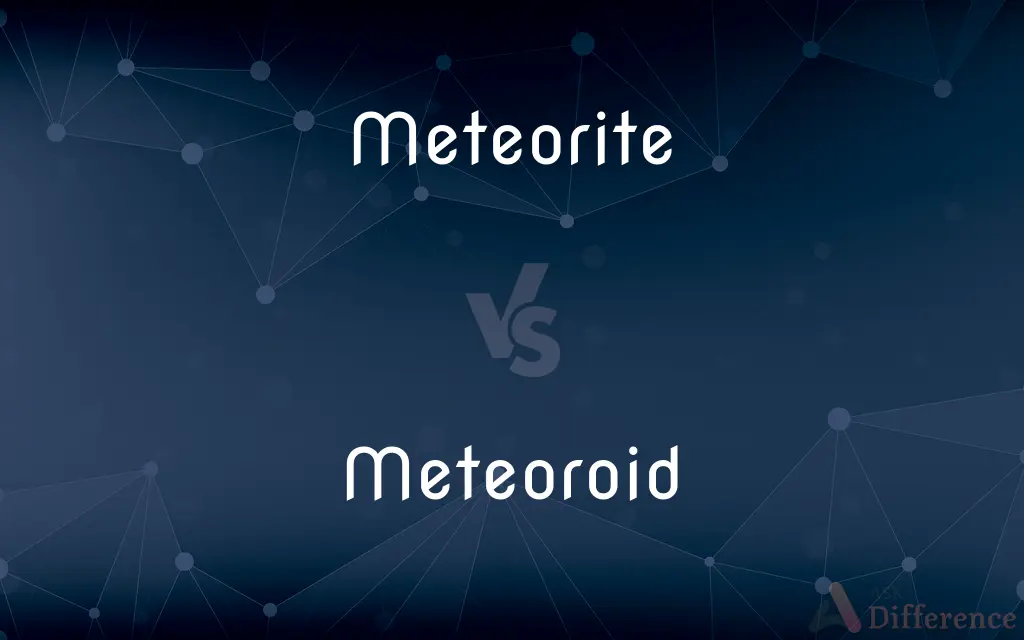Meteorite vs. Meteoroid — What's the Difference?
By Tayyaba Rehman & Urooj Arif — Updated on May 2, 2024
Meteoroids are small celestial bodies traveling through space, while meteorites are meteoroids that survive Earth's atmosphere and strike the ground.

Difference Between Meteorite and Meteoroid
Table of Contents
ADVERTISEMENT
Key Differences
Meteoroids are typically composed of rock or metal and originate from comets or asteroids. These small celestial bodies, often ranging in size from dust particles to small boulders, travel through space. On the other hand, meteorites are meteoroids that enter Earth’s atmosphere and are able to reach the Earth's surface without burning up completely. This transition from meteoroid to meteorite occurs during their passage through the atmosphere.
Meteoroids exist in space, orbiting the sun just like planets and asteroids. They become visible as meteors or "shooting stars" when they enter Earth's atmosphere due to the heat generated by atmospheric friction. Whereas meteorites provide scientists with actual samples of celestial material, offering valuable insights into the composition of the solar system and the origins of these space rocks.
The size of meteoroids can vary greatly, but most are smaller than a meter in diameter. This small size usually results in their complete vaporization in the atmosphere as meteors. On the other hand, meteorites are the rare, larger remnants that survive their fiery passage through the atmosphere and are found on Earth’s surface, sometimes creating craters.
Meteoroids often remain unnoticed until they enter Earth's atmosphere and create a visible streak of light. Conversely, meteorites, once landed, are sought after for scientific research and collection, often being displayed in museums or used in educational settings.
The study of meteoroids involves observations and predictions about their paths and potential to become meteors. In contrast, studying meteorites involves physical examination of the rock to understand its chemical and isotopic composition, providing direct evidence about the processes that occur in the outer space.
ADVERTISEMENT
Comparison Chart
Definition
Small celestial body traveling through space
Meteoroid that reaches Earth's surface
Location
In space
On Earth
Observation
Visible when entering Earth’s atmosphere
Found after impacting Earth
Composition
Rock, metal
Rock, metal, often with unique isotopes
Scientific Value
Studied from afar, predicted paths
Directly studied for composition
Compare with Definitions
Meteorite
Originates from comets or asteroids.
That meteoroid may have been a fragment from an ancient comet.
Meteoroid
A meteoroid that has landed on Earth.
The newly discovered meteorite is being studied for its unique minerals.
Meteorite
A celestial body in orbit around the sun.
Scientists are tracking the size and orbit of various meteoroids.
Meteoroid
Can be found on Earth’s surface.
Meteorite hunters search the desert for these rare space rocks.
Meteorite
A small rock or particle in space.
The telescope captured images of a meteoroid passing close to Earth.
Meteoroid
Valuable for scientific research.
Researchers are analyzing the meteorite to learn more about the solar system.
Meteorite
Can enter Earth’s atmosphere.
If a meteoroid enters Earth’s atmosphere, it might become a visible meteor.
Meteoroid
Survives atmospheric entry.
That meteorite must have been quite large to survive its journey through the atmosphere.
Meteorite
Mostly vaporizes as a meteor.
The meteoroid created a spectacular light show as it vaporized in the atmosphere.
Meteoroid
Often creates craters.
The meteorite impact is believed to have created this ancient crater.
Meteorite
A meteorite is a solid piece of debris from an object, such as a comet, asteroid, or meteoroid, that originates in outer space and survives its passage through the atmosphere to reach the surface of a planet or moon. When the original object enters the atmosphere, various factors such as friction, pressure, and chemical interactions with the atmospheric gases cause it to heat up and radiate energy.
Meteoroid
A meteoroid () is a small rocky or metallic body in outer space. Meteoroids are significantly smaller than asteroids, and range in size from small grains to one-meter-wide objects.
Meteorite
A stony or metallic mass of matter that has fallen to the earth's surface from outer space.
Meteoroid
A solid body, moving in interplanetary space, that is smaller than an asteroid and at least as large as a speck of dust.
Meteorite
A metallic or stony object or body that is the remains of a meteoroid.
Meteoroid
(astronomy) A relatively small (sand- to boulder-sized) fragment of debris in a star system that produces a meteor when it hits the atmosphere
Meteorite
A mass of stone or iron which has fallen to the earth from space; an aërolite.
Meteoroid
A small body moving through space, or revolving about the sun, which on entering the earth's atmosphere would be deflagrated and appear as a meteor.
These bodies [small, solid bodies] before they come into the air, I call meteoroids.
Meteorite
Stony or metallic object that is the remains of a meteoroid that has reached the earth's surface
Meteoroid
(astronomy) any of the small solid extraterrestrial bodies that hits the earth's atmosphere
Common Curiosities
Where do meteoroids come from?
Meteoroids come from comets or the asteroid belt, often as debris from collisions or the sublimation of cometary ice.
How can meteorites be identified?
Meteorites are usually identified by their burnt exterior, unique density, and sometimes magnetic properties.
Can meteorites be dangerous?
Large meteorites can be dangerous and have caused significant damage in past events, but such large impacts are extremely rare.
How often do meteorites hit Earth?
While small meteorites fall to Earth frequently, large impacts are rare, occurring once every few thousand years.
Why are meteoroids not visible in the sky like stars?
Meteoroids are usually too small and too far away to be seen until they burn up as meteors in the Earth's atmosphere.
How does a meteoroid become a meteorite?
A meteoroid becomes a meteorite if it survives the heat of entering Earth's atmosphere and impacts the ground.
Are all meteoroids the same size?
No, meteoroids vary greatly in size from tiny grains to boulders several meters across.
What is the difference between a meteor and a meteorite?
A meteor is the light phenomenon which occurs when a meteoroid enters the Earth's atmosphere, while a meteorite is what remains on Earth after a meteoroid survives atmospheric entry.
How are meteorites collected?
Meteorites are collected after being located on the ground, often using visual searches or magnetic detectors.
What is a meteoroid?
A meteoroid is a small rock or metal body traveling through space, usually originating from comets or asteroids.
Can meteorites be sold or owned by private individuals?
Yes, meteorites can be owned and sold legally, although some countries have laws protecting meteorites as national heritage.
What scientific information can meteorites provide?
Meteorites can provide information about the early solar system, including the age and composition of other celestial bodies.
Are meteorites radioactive?
Most meteorites are not radioactive enough to pose health risks, although they may contain trace amounts of radioactive elements.
What is the difference in composition between meteoroids and meteorites?
The composition can be similar, but meteorites often contain preserved minerals and isotopes altered by their passage through the atmosphere.
Do all meteoroids become meteorites?
No, most meteoroids burn up in the atmosphere and only a small fraction reach the Earth as meteorites.
Share Your Discovery

Previous Comparison
Current vs. Latest
Next Comparison
Puny vs. PunnyAuthor Spotlight
Written by
Tayyaba RehmanTayyaba Rehman is a distinguished writer, currently serving as a primary contributor to askdifference.com. As a researcher in semantics and etymology, Tayyaba's passion for the complexity of languages and their distinctions has found a perfect home on the platform. Tayyaba delves into the intricacies of language, distinguishing between commonly confused words and phrases, thereby providing clarity for readers worldwide.
Co-written by
Urooj ArifUrooj is a skilled content writer at Ask Difference, known for her exceptional ability to simplify complex topics into engaging and informative content. With a passion for research and a flair for clear, concise writing, she consistently delivers articles that resonate with our diverse audience.
















































